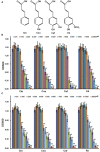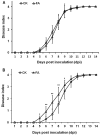Ferulic Acid, But Not All Hydroxycinnamic Acids, Is a Novel T3SS Inducer of Ralstonia solanacearum and Promotes Its Infection Process in Host Plants under Hydroponic Condition
- PMID: 28955375
- PMCID: PMC5601421
- DOI: 10.3389/fpls.2017.01595
Ferulic Acid, But Not All Hydroxycinnamic Acids, Is a Novel T3SS Inducer of Ralstonia solanacearum and Promotes Its Infection Process in Host Plants under Hydroponic Condition
Abstract
Hydroxycinnamic acids (HCAs) are typical monocyclic phenylpropanoids, including cinnamic acid (Cin), coumaric acid (Cou), caffeic acid (Caf), ferulic acid (FA) and their isomers, and involved in the interactions between pathogens and host plants. Here, we focused on the impact of HCAs on expression of type III secretion system (T3SS) in Ralstonia solanacearum. FA significantly induced the expression of the T3SS and some type III effectors (T3Es) genes in hrp-inducing medium, while did not the other HCAs. However, exogenously supplemented FA did not affect the T3SS expression in planta and the elicitation of the hypersensitive response (HR) in tobacco leaves. Consistent with its central roles in pathogenicity, the FA-induced expression of the T3SS led to significant promotion on infection process of R. solanacearum in tomato plants under hydroponics cultivation. Moreover, the FA-induced expression of the T3SS was specifically mediated by the well-characterized signaling cascade PrhA-prhI/R-PrhJ-HrpG-HrpB, independent of the other known regulatory pathways. In summary, our results demonstrated that FA, a novel inducer of the T3SS in R. solanacearum, was able to promote its infection process in host plants under hydroponics condition.
Keywords: Hrp regulon; Ralstonia solanacearum; hydroxycinnamic acids; pathogenesis; type III secretion system.
Figures







Similar articles
-
A putative LysR-type transcriptional regulator PrhO positively regulates the type III secretion system and contributes to the virulence of Ralstonia solanacearum.Mol Plant Pathol. 2018 Jan 24;19(8):1808-19. doi: 10.1111/mpp.12660. Online ahead of print. Mol Plant Pathol. 2018. PMID: 29363870 Free PMC article.
-
Involvement of NpdA, a Putative 2-Nitropropane Dioxygenase, in the T3SS Expression and Full Virulence in Ralstonia solanacearum OE1-1.Front Microbiol. 2017 Oct 11;8:1990. doi: 10.3389/fmicb.2017.01990. eCollection 2017. Front Microbiol. 2017. PMID: 29075251 Free PMC article.
-
Involvement of a PadR regulator PrhP on virulence of Ralstonia solanacearum by controlling detoxification of phenolic acids and type III secretion system.Mol Plant Pathol. 2019 Nov;20(11):1477-1490. doi: 10.1111/mpp.12854. Epub 2019 Aug 8. Mol Plant Pathol. 2019. PMID: 31392803 Free PMC article.
-
[Advances in studies of the type III secretion system in Ralstonia solanacearum--A review].Wei Sheng Wu Xue Bao. 2015 Jun 4;55(6):675-82. Wei Sheng Wu Xue Bao. 2015. PMID: 26562991 Review. Chinese.
-
Regulation Involved in Colonization of Intercellular Spaces of Host Plants in Ralstonia solanacearum.Front Plant Sci. 2017 Jun 8;8:967. doi: 10.3389/fpls.2017.00967. eCollection 2017. Front Plant Sci. 2017. PMID: 28642776 Free PMC article. Review.
Cited by
-
A putative LysR-type transcriptional regulator PrhO positively regulates the type III secretion system and contributes to the virulence of Ralstonia solanacearum.Mol Plant Pathol. 2018 Jan 24;19(8):1808-19. doi: 10.1111/mpp.12660. Online ahead of print. Mol Plant Pathol. 2018. PMID: 29363870 Free PMC article.
-
Bacterial Tomato Pathogen Ralstonia solanacearum Invasion Modulates Rhizosphere Compounds and Facilitates the Cascade Effect of Fungal Pathogen Fusarium solani.Microorganisms. 2020 May 27;8(6):806. doi: 10.3390/microorganisms8060806. Microorganisms. 2020. PMID: 32471167 Free PMC article.
-
The Role of Hydroxycinnamic Acid Amide Pathway in Plant Immunity.Front Plant Sci. 2022 Jun 22;13:922119. doi: 10.3389/fpls.2022.922119. eCollection 2022. Front Plant Sci. 2022. PMID: 35812905 Free PMC article. Review.
-
The Lifecycle of the Plant Immune System.CRC Crit Rev Plant Sci. 2020;39(1):72-100. doi: 10.1080/07352689.2020.1757829. Epub 2020 May 18. CRC Crit Rev Plant Sci. 2020. PMID: 33343063 Free PMC article.
-
Apoplast Metabolomics Profiling Reveals Nitrogen-Dependent Modulation of Plant-Pathogen Interactions.Mol Plant Pathol. 2025 Jun;26(6):e70110. doi: 10.1111/mpp.70110. Mol Plant Pathol. 2025. PMID: 40560929 Free PMC article.
References
-
- Angot A., Peeters N., Lechner E., Vailleau F., Baud C., Gentzbittel L., et al. (2006). Ralstonia solanacearum requires F-box-like domain-containing type III effectors to promote disease on several host plants. Proc. Natl. Acad. Sci. U.S.A. 103 14620–14625. 10.1073/pnas.0509393103 - DOI - PMC - PubMed
-
- Araud-Razou I., Vasse J., Montrozier H., Etchebar C., Trigalet A. (1998). Detection and visualization of the major acidic exopolysaccharide of Ralstonia solanacearum and its role in tomato root infection and vascular colonization. Eur. J. Plant Pathol. 104 795–809. 10.1023/A:1008690712318 - DOI
LinkOut - more resources
Full Text Sources
Other Literature Sources

